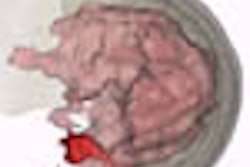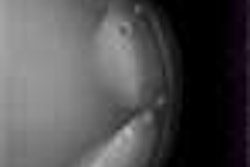SEATTLE - Full-field digital mammography shaves crucial minutes off exam times when compared with screen-film procedures, resulting in higher productivity for breast imagers, according to Canadian researchers at the American Roentgen Ray Society conference on Thursday.
"We assessed for homogeneity between the digital and analog groups based on the technologist assessment of image quality and the patients age," said Dr. Elaine O’Riordan from the University Health Network and Mount Sinai Hospital in Toronto.
For this study, the exam time for 1,000 consecutive digital mammograms (Senographe 2000D, GE Medical Systems, Waukesha, WI) was recorded, as was the exam time for 1,000 consecutive four-view, screen-film mammograms. The exam time consisted of the arrival of the patient into the exam room; the time needed to take a patient history; and the time for image acquisition, processing, and assessment by the technologist.
At 7.3 minutes, the mean total exam time for FFDM was significantly shorter than the total exam time of screen-film at 12.6 minutes. The latter required 9.4 minutes of acquisition time and 3.2 minutes of processing and image quality assessment, O’Riordan said.
In order to obtain an optimal four-view screen-film mammogram, the re-exposure (for extended views and repositioning) was 7.4%, slightly higher than the 4.4% re-exposure rate for FFDM. The recall rate (for spot magnification and follow-up with ultrasound) for the analog exam was 6.7%, exactly one percentage point higher than that of digital mammography.
The patient’s age did not play a role in the exam time of either FFDM or analog mammography, O’Riordan said. Screen-film mammography still took longer regardless of age.
A learning curve was most likely in effect with FFDM, because the exam time for the last 30 patients was shorter than the exam time for the first 30 patients, O’Riordan said.
Session moderator Dr. Shalom Buchbinder asked if O’Riordan’s group had assessed the impact of FFDM on how long it took the radiologists to read the film. In a presentation at the 2001 RSNA conference, O’Riordan reported that doctors required additional time for the manipulation of FFDM images. As a result, the final exam time was a few seconds longer for FFDM, O’Riordan said. However, the difference in reporting time between digital and analog was not statistically significant based on that previous study.
Other recent research has highlighted the various strengths of FFDM. At the 2001 RSNA show, a group from the University of Colorado in Denver reported a significant difference in recall rates between FFDM and screen-film mammography: Out of 6,768 exams, 11.9% of FFDM studies were recalled, compared to 15% of analog studies.
At the 2001 European Congress of Radiology, German researchers reported good image quality and lesion detectability in 100 patients who were screened with digital as well as screen-film mammography. Image contrast was considered good in 99% of the FFDM exams versus 76% of the analog exams. In a separate study, another German group found that digital mammography detected more lesions at 30% less radiation dose than traditional mammography.
Still, FFDM has a way to go before gaining wider acceptance. In February, the U.S. Food and Drug Administration issued new guidelines stating that only mammography centers, which are accredited to perform analog exams, are allowed to perform digital mammography procedures. The policy was designed to limit the use of digital systems until quality assurance procedures are in place.
A month later, the Institute of Medicine issued a report stating that screen-film mammography remained the gold standard for routine screening. In the report, an IOM evaluating committee said that digital mammography may offer technical advantages, but has yet to prove itself as more accurate than analog exams.
By Shalmali Pal
AuntMinnie.com staff writer
May 4, 2001
Click here to post your comments about this story. Please include the headline of the article in your message.
Copyright © 2001 AuntMinnie.com



















